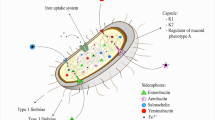Abstract
In this study, a combination of recA-based PCR assays and 16S rDNA restriction fragment length polymorphism (RFLP) analysis was used to determine the genomovar diversity of clinical Burkholderia cepacia complex isolates. Twenty-eight isolates were prospectively collected from patients attending a large Australian adult cystic fibrosis (CF) unit, 22 isolates were referred from other Australian CF units and a further eight isolates originated from patients without CF. The 28 prospectively collected isolates were distributed amongst the following genomovars: Burkholderia cepacia genomovar I (28.6%), Burkholderia multivorans (21.4%), Burkholderia cepacia genomovar III (39.3%), Burkholderia vietnamiensis (3.6%) and Burkholderia ambifaria (7.1%). The results of this study highlight the usefulness of 16S rDNA RFLP typing for the identification of other Burkholderia spp. and non-fermenting gram-negative bacteria.
Similar content being viewed by others
References
Ledson MJ, Gallagher MJ, Jackson M, Hart CA, Walshaw MJ (2002) Outcome of Burkholderia cepacia colonisation in an adult cystic fibrosis centre. Thorax 57:142–145
Saiman L, Macdonald N, Burns JL, Hoiby N, Speert DP, Weber D (2000) Infection control in cystic fibrosis: practical recommendations for the hospital, clinic, and social settings. Am J Infect Control 28:381–385
Yankaskas JR, Mallory GB Jr (1998) Lung transplantation in cystic fibrosis: consensus conference statement. Chest 113:217–226
Coenye T, Vandamme P, Govan JR, LiPuma JJ (2001) Taxonomy and identification of the Burkholderia cepacia complex. J Clin Microbiol 39:3427–3436
Vandamme P, Henry D, Coenye T et al. (2002) Burkholderia anthina sp. nov. and Burkholderia pyrrocinia, two additional Burkholderia cepacia complex bacteria, may confound results of new molecular diagnostic tools. FEMS Immunol Med Microbiol 33:143–149
Mahenthiralingam E, Bischof J, Byrne SK et al. (2000) DNA-based diagnostic approaches for identification of Burkholderia cepacia complex, Burkholderia vietnamiensis, Burkholderia multivorans, Burkholderia stabilis, and Burkholderia cepacia genomovars I and III. J Clin Microbiol 38:3165–3173
Henry DA, Mahenthiralingam E, Vandamme P, Coenye T, Speert DP (2001) Phenotypic methods for determining genomovar status of the Burkholderia cepacia complex. J Clin Microbiol 39:1073–1078
Mahenthiralingam E, Coenye T, Chung JW et al. (2000) Diagnostically and experimentally useful panel of strains from theBurkholderia cepacia complex. J Clin Microbiol 38:910–913
Segonds C, Heulin T, Marty N, Chabanon G (1999) Differentiation of Burkholderia species by PCR-restriction fragment length polymorphism analysis of the 16S rRNA gene and application to cystic fibrosis isolates. J Clin Microbiol 37:2201–2208
Bauernfeind A, Schneider I, Jungwirth R, Roller C (1999) Discrimination of Burkholderia multivorans and Burkholderia vietnamiensis from Burkholderia cepacia genomovars I, III, and IV by PCR. J Clin Microbiol 37:1335–1339
Speert DP, Henry D, Vandamme P, Corey M, Mahenthiralingam E (2002) Epidemiology of Burkholderia cepacia complex in patients with cystic fibrosis, Canada. Emerg Infect Dis 8:181–187
Crowley D, Daly M, Lucey B et al. (2002) Molecular epidemiology of cystic fibrosis-linked Burkholderia cepacia complex isolates from three national referral centres in Ireland. J Appl Microbiol 92:992–1004
Paul ML, Pegler MA, Benn RA (1998) Molecular epidemiology of Burkholderia cepacia in two Australian cystic fibrosis centres. J Hosp Infect 38:19–26
Mahenthiralingam E, Campbell ME, Henry DA, Speert DP (1996) Epidemiology of Burkholderia cepacia infection in patients with cystic fibrosis: analysis by randomly amplified polymorphic DNA fingerprinting. J Clin Microbiol 34:2914–2920
Soni R, Marks G, Henry DA et al. (2002) Effect ofBurkholderia cepacia infection in the clinical course of patients with cystic fibrosis: a pilot study in a Sydney clinic. Respirology 7:241–245
Acknowledgements
This study was supported by The Prince Charles Hospital Foundation and the Trust Fund of the Queensland Health Pathology Service. We gratefully acknowledge Dr. Philip Masel for allowing us the opportunity to study patients under his care, the Staff of the Microbiology Department and clinicians and scientists who kindly referred isolates from the following centres: The Royal Brisbane and Royal Childrens Hospitals, Sullivan Nicolaides Pathology, Queensland Medical Laboratory, Mater Misericordiae Hospital, Brisbane; Royal Prince Alfred Hospital, Westmead Hospital, Sydney; The Alfred Hospital, Melbourne; Institute for Medical and Veterinary Science, and the Women's and Childrens Hospital, Adelaide. We also thank Dr. J.E. Moore, for his kind provision of a number of Burkholderia cepacia control strains. The experiments performed in this study comply with current Australian law.
Author information
Authors and Affiliations
Corresponding author
Rights and permissions
About this article
Cite this article
Kidd, T.J., Bell, S.C. & Coulter, C. Genomovar Diversity Amongst Burkholderia cepacia Complex Isolates From an Australian Adult Cystic Fibrosis Unit. Eur J Clin Microbiol Infect Dis 22, 434–437 (2003). https://doi.org/10.1007/s10096-003-0949-8
Published:
Issue Date:
DOI: https://doi.org/10.1007/s10096-003-0949-8




